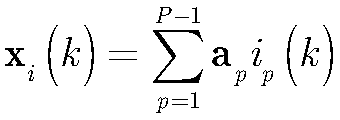Robust beam forming method based on steering vector and space power estimation
A steering vector and space technology, applied in the field of signal processing, can solve the problems of the decrease of the output signal-to-noise ratio of the receiving end, affecting the overall performance of the system, and the deviation of weight design weights, so as to achieve accurate signal steering vector estimation and achieve accurate estimation. Effect
- Summary
- Abstract
- Description
- Claims
- Application Information
AI Technical Summary
Problems solved by technology
Method used
Image
Examples
Embodiment 1
[0088] The present invention simulates the change of the signal-to-interference and noise ratio of the beam output signal-to-noise ratio with the expected signal-to-noise ratio of the signal steering vector estimation algorithm with errors in the signal and interference direction of arrival:
[0089] A uniform linear array composed of 10 omnidirectional array elements receives narrowband signals emitted by 3 far-field sources, estimated signals and interference directions The relationship with the true arrival direction θ is Among them, Δθ is a uniform distribution in the interval [-8°, 8°]. When strong interference occurs in the main lobe of the beam, it is assumed that the estimated direction of arrival of the signal is The estimated arrival azimuths of the two interferences are The corresponding interference-to-noise ratio is 30dB. For the desired signal, set ρ=0.9 and the input signal-to-noise ratio change range is -10 to 30dB. The number of snapshots of the array is 30, ...
Embodiment 2
[0097] A uniform linear array composed of 10 omnidirectional array elements receives narrowband signals emitted by 3 far-field sources, estimated signals and interference directions The relationship with the true arrival direction θ is Among them, Δθ is a uniform distribution in the interval [-8°, 8°]. When strong interference occurs in the main lobe of the beam, it is assumed that the estimated direction of arrival of the signal is The estimated arrival azimuths of the two interferences are The corresponding interference-to-noise ratio is 30dB. For the desired signal, set ρ=0.9 and the input signal-to-noise ratio is 20dB. The number of snapshots of the array varies from 10 to 100, and 200 Monte Carlo experiments are performed. In each Monte Carlo experiment, the error of the signal and interference direction of arrival obeys the above-mentioned uniform distribution.
[0098] details as follows:
[0099] ① Perform discrete sampling in the angle interval where the signal is loc...
PUM
 Login to View More
Login to View More Abstract
Description
Claims
Application Information
 Login to View More
Login to View More - R&D
- Intellectual Property
- Life Sciences
- Materials
- Tech Scout
- Unparalleled Data Quality
- Higher Quality Content
- 60% Fewer Hallucinations
Browse by: Latest US Patents, China's latest patents, Technical Efficacy Thesaurus, Application Domain, Technology Topic, Popular Technical Reports.
© 2025 PatSnap. All rights reserved.Legal|Privacy policy|Modern Slavery Act Transparency Statement|Sitemap|About US| Contact US: help@patsnap.com



